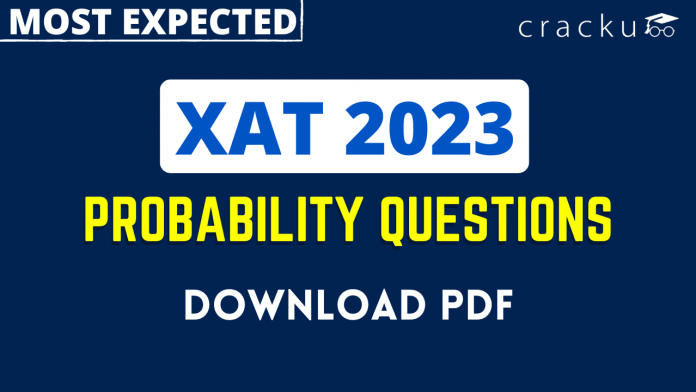XAT Probability Questions [Important PDF]
Download Probability Questions for XAT PDF – XAT Probability questions pdf by Cracku. Practice XAT solved Probability Questions paper tests, and these are the practice question to have a firm grasp on the Probability topic in the XAT exam. Top 20 very Important Probability Questions for XAT based on asked questions in previous exam papers. The XAT question papers contain actual questions asked with answers and solutions.
Download Probability Questions for XAT
Enroll to XAT 2023 Crash Course
Question 1: In a box carrying one dozen of oranges one third have become bad.If 3 oranges taken out from the box random ,what is the probability that at least one orange out of the 3 oranges picked up is good ?
a) 1/55
b) 54/55
c) 45/55
d) 3/55
e) None of these
1) Answer (B)
Solution:
Total number of oranges in the box = 12
Number of ways of selecting 3 oranges out of 12 oranges, n(S) = $C^{12}_3$
= $\frac{12 \times 11 \times 10}{1 \times 2 \times 3} = 220$
Number of oranges which became bad = $\frac{12}{3}=4$
Number of ways of selecting 3 oranges out of 4 bad oranges = $C^4_3 = C^4_1 = 4$
Number of desired selection of oranges, n(E) = 220 – 4 = 216
$\therefore$ $P(E) = \frac{n(E)}{n(S)}$
= $\frac{216}{220}= \frac{54}{55}$
=> Ans – (B)
Instructions
Study the information carefully to answer the following questions:
A bucket contains 8 red, 3 blue and 5 green marbles.
Question 2: If 3 marbles are drawn at random, what is the probability that none is red ?
a) ${3 \over 8}$
b) ${1 \over {16}}$
c) ${1 \over {10}}$
d) ${3 \over {16}}$
e) None of these
2) Answer (C)
Solution:
Number of ways of drawing 3 marbles out of 16
$n(S) = C^{16}_3 = \frac{16 \times 15 \times 14}{1 \times 2 \times 3}$
= $560$
Out of the three drawn marbles, none is red, i.e., they will be either blue or green.
=> $n(E) = C^8_3 = \frac{8 \times 7 \times 6}{1 \times 2 \times 3}$
= $56$
$\therefore$ Required probability = $\frac{n(E)}{n(S)}$
= $\frac{56}{560} = \frac{1}{10}$
Question 3: If 2 marbles are drawn at random, what is the probability that both are green?
a) ${1 \over 8}$
b) ${5 \over {16}}$
c) ${2 \over 7}$
d) ${3 \over 8}$
e) None of these
3) Answer (E)
Solution:
Number of ways of drawing 2 marbles out of 16
$n(S) = C^{16}_2 = \frac{16 \times 15}{1 \times 2}$
= $120$
Out of the two drawn marbles, both are green
=> $n(E) = C^5_2 = \frac{5 \times 4}{1 \times 2}$
= $10$
$\therefore$ Required probability = $\frac{n(E)}{n(S)}$
= $\frac{10}{120} = \frac{1}{12}$
Question 4: If 4 marbles are drawn at random, what is the probability that 2 are red and 2 are blue ?
a) ${{11} \over {16}}$
b) ${3 \over {16}}$
c) ${11 \over {72}}$
d) ${3 \over {65}}$
e) None of these
4) Answer (D)
Solution:
Number of ways of drawing 4 marbles out of 16
=> $n(S) = C^{16}_4 = \frac{16 \times 15 \times 14 \times 13}{1 \times 2 \times 3 \times 4}$
= $1820$
Out of the four drawn marbles, 2 are red and 2 are blue.
=> $n(E) = C^8_2 \times C^3_2 = \frac{8 \times 7}{1 \times 2} \times \frac{3 \times 2}{1 \times 2}$
= $28 \times 3 = 84$
$\therefore$ Required probability = $\frac{n(E)}{n(S)}$
= $\frac{84}{1820} = \frac{3}{65}$
Question 5: A bag A contains 4 green and 6 red balls. Another bag B contains 3 green and 4 red balls. If one
ball is drawn from each bag, and the probability that both are green.
a) 13/70
b) 1/4
c) 6/35
d) 8/35
e) None of these
5) Answer (C)
Solution:
Total balls in bag A = 4 + 6 = 10
Probability that ball is green = $\frac{4}{10}$
Total balls in bag B = 3 + 4 = 7
Probability that ball is green = $\frac{3}{7}$
=> Required probability = $\frac{4}{10} \times \frac{3}{7}$
= $\frac{6}{35}$
Question 6: A bag A contains 4 green and 6 red balls. Another bag B contains 3 green and 4 red balls. If one
ball is drawn from each bag, and the probability that both are green.
a) 13/70
b) 1/4
c) 6/35
d) 8/35
e) None of these
6) Answer (C)
Solution:
Total balls in bag A = 4 + 6 = 10
Probability that ball is green = $\frac{4}{10}$
Total balls in bag B = 3 + 4 = 7
Probability that ball is green = $\frac{3}{7}$
=> Required probability = $\frac{4}{10} \times \frac{3}{7}$
= $\frac{6}{35}$
Question 7: A bag contains 2 red, 3 green and 2 blue balls. 2 balls are to be drawn randomly. What is the probability that the balls drawn contain no blue ball ?
a) 5/7
b) 10/21
c) 2/7
d) 11/21
e) None of these
7) Answer (B)
Solution:
Total number of balls = 2 + 3 + 2 = 7
Total number of outcomes = Drawing 2 balls out of 7
= $C^7_2 = \frac{7 \times 6}{1 \times 2} = 21$
Favourable outcomes = Drawing 2 balls out of 5 (so that none is blue)
= $C^5_2 = \frac{5 \times 4}{1 \times 2} = 10$
=> Required probability = $\frac{10}{21}$
Question 8: There are 8 brown balls, 4 orange balls and 5 black balls in a bag. Five balls are chosen at random. What is the probability of their being 2 brown balls, 1 orange ball and 2 black balls ?
a) $\frac{191}{1547}$
b) $\frac{180}{1547}$
c) $\frac{280}{1547}$
d) $\frac{189}{1547}$
e) None of these
8) Answer (C)
Solution:
Total number of balls in the bag = 8 + 4 + 5 = 17
P(S) = Total possible outcomes
= Selecting 5 balls at random out of 17
=> $P(S) = C^{17}_5 = \frac{17 \times 16 \times 15 \times 14 \times 13}{1 \times 2 \times 3 \times 4 \times 5}$
= $6188$
P(E) = Favorable outcomes
= Selecting 2 brown, 1 orange and 2 black balls.
=> $P(E) = C^8_2 \times C^4_1 \times C^5_2$
= $\frac{8 \times 7}{1 \times 2} \times 4 \times \frac{5 \times 4}{1 \times 2}$
= $28 \times 4 \times 10 = 1120$
$\therefore$ Required probability = $\frac{P(E)}{P(S)}$
= $\frac{1120}{6188} = \frac{280}{1547}$
Question 9: In a bag there are 4 white, 4 red and 2 green balls. Two balls are drawn at random. What is the probability that at least one ball is of green colour ?
a) $\frac{4}{5}$
b) $\frac{3}{5}$
c) $\frac{1}{5}$
d) $\frac{2}{5}$
e) None of these
9) Answer (D)
Solution:
There are 4 white, 4 red and 2 green balls and two balls are drawn at random.
Total possible outcomes = Selection of 2 balls out of 10 balls
= $C^{10}_2 = \frac{10 * 9}{1 * 2} = 45$
Favourable outcomes = 1 green ball and 1 ball of other colour + 2 green balls
= $C^2_1 \times C^8_1 + C^2_2$
= 2*8 + 2 = 18
$\therefore$ Required probability = $\frac{18}{45} = \frac{2}{5}$
Question 10: A bag contains 3 white balls and 2 black balls. Another bag contains 2 white and 4 black balls. A bag and a ball are picked at random. What is the probability that the ball drawn is white ?
a) $\frac{7}{11}$
b) $\frac{7}{30}$
c) $\frac{5}{11}$
d) $\frac{7}{15}$
e) $\frac{8}{15}$
10) Answer (D)
Solution:
Probability of choosing bag 1 = (1/2)
Probability of choosing bag 2 = (1/2)
Probability of choosing white ball from bag 1 = 3/5
Probability of choosing white ball from bag 2 = 2/6
Probability of choosing bag 1 and white ball from it = (1/2)(3/5) = 3/10
Probability of choosing bag 2 and white ball from it = (1/2)(2/6) = 2/12
Probability of choosing a bag and drawing a white ball = (3/10) + (2/12) = (28/60) = (7/15)
Option D is the correct answer.
Question 11: A bag contains 3 white balls and 2 black balls. Another bag contains 2 white and 4 black balls. A bag and a ball are picked at random. What is the probability that the ball drawn is white ?
a) $\frac{7}{11}$
b) $\frac{7}{30}$
c) $\frac{5}{11}$
d) $\frac{7}{15}$
e) $\frac{8}{15}$
11) Answer (D)
Solution:
Probability of choosing bag 1 = (1/2)
Probability of choosing bag 2 = (1/2)
Probability of choosing white ball from bag 1 = 3/5
Probability of choosing white ball from bag 2 = 2/6
Probability of choosing bag 1 and white ball from it = (1/2)(3/5) = 3/10
Probability of choosing bag 2 and white ball from it = (1/2)(2/6) = 2/12
Probability of choosing a bag and drawing a white ball = (3/10) + (2/12) = (28/60) = (7/15)
Option D is the correct answer.
Question 12: In a bag, there are 6 red balls and 9 green balls. Two balls are drawn at random, what is the probability that at least one of the balls drawn is red ?
a) 29/35
b) 7/15
c) 23/35
d) 2/5
e) 19/35
12) Answer (C)
Solution:
Probability that at least 1 ball is red = 1 – probability that none of them is red.
Probability that none if the two balls is red = (9/15)(8/14)
Probability that at least 1 ball is red = 1 – probability that none of them is red. = 1- [(9/15)(8/14)] = (210-72)/210
= 138/210
=23/35
Option C is the correct answer.
Question 13: In a bag, there are 6 red balls and 9 green balls. Two balls are drawn at random, what is the probability that at least one of the balls drawn is red ?
a) 29/35
b) 7/15
c) 23/35
d) 2/5
e) 19/35
13) Answer (C)
Solution:
Probability that at least 1 ball is red = 1 – probability that none of them is red.
Probability that none if the two balls is red = (9/15)(8/14)
Probability that at least 1 ball is red = 1 – probability that none of them is red. = 1- [(9/15)(8/14)] = (210-72)/210
= 138/210
=23/35
Option C is the correct answer.





